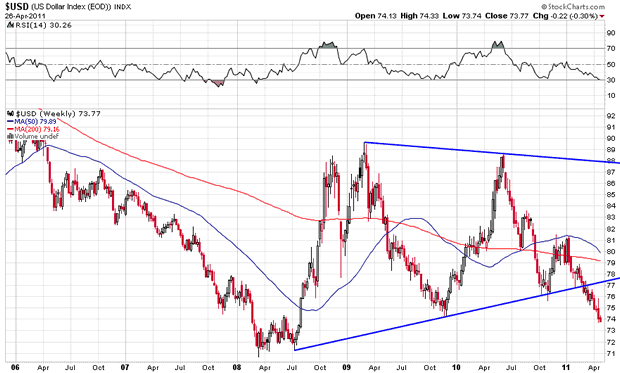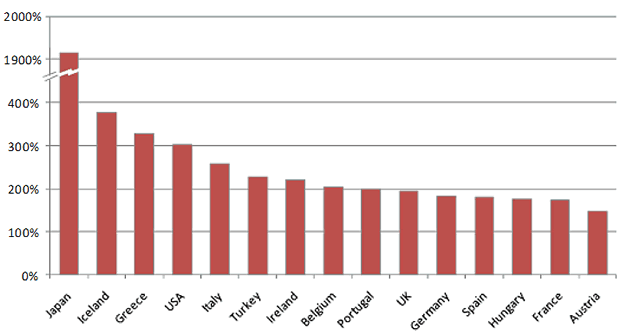Endless Money Printing Quantitative Easing
Interest-Rates / Quantitative Easing May 27, 2011 - 12:24 PM GMTBy: Puru_Saxena
 Over the past few weeks, we have spent a lot of time digging into the macro data pertaining to the world's developed economies. After careful analysis, our research has convinced us that quantitative easing (money creation out of thin air) will not end anytime soon.
Over the past few weeks, we have spent a lot of time digging into the macro data pertaining to the world's developed economies. After careful analysis, our research has convinced us that quantitative easing (money creation out of thin air) will not end anytime soon.
In fact, we believe that quantitative easing will only end when there is a run on one, or some of the world's major currencies. Remember, the world is governed by short-sighted politicians and as long as the policymakers continue to 'kick the can down the road', quantitative easing (destruction of the purchasing power of money) cannot and will not end.
Figure 1 captures the state of the American currency. It shows that the US Dollar Index has recently broken below an important support level and is currently in free-fall. Furthermore, it is notable that the US Dollar's downtrend commenced last summer when the Federal Reserve announced the second round of quantitative easing. Now, the Federal Reserve may continue to argue that its quantitative easing program is not inflationary but the market clearly does not like the dilution of the existing money stock.
Figure 1: Is this really the world's reserve currency?

Source: www.stockcharts.com
It is notable that since the credit crisis in 2008, the Federal Reserve has created over US$2 trillion new dollars via its various programs. Some of this newly created money was spent on buying dubious mortgage backed securities from the banks at inflated prices. More recently, a large percentage of the money was lent directly to the US government. In fact, PIMCO believes that since last summer, approximately 70% of newly issued US Treasury securities have been bought by the Federal Reserve!
With the latest round of quantitative easing ending in June, the market is now waiting for the Federal Reserve's next move. However, if a recent Bloomberg news release is any guide, the central bank plans to continue lending money to the US government (by purchasing additional US Treasury securities from the proceeds of the maturing mortgage backed securities).
So, based on the Federal Reserve's intentions, it should be clear to everyone that Mr. Bernanke will keep financing the American government's deficit. Given the fact that foreign demand for US Treasury securities is waning and China has been a net seller for four consecutive months, it is hardly surprising that the Federal Reserve has stepped up as the lender of last resort. After all, Mr. Bernanke knows full well that if he stops lending money to the US government, interest rates will rise significantly which in turn will exert tremendous pressure on the American public. If interest rates surge anytime soon, millions of indebted Americans may default on their debt; thereby bankrupting the American financial institutions.
More importantly, rising interest rates will also exert tremendous pressure on the American government. It is noteworthy that America's federal debt has already climbed to US$14.2 trillion and every one percentage point increase in the cost of capital will cost an extra US$142 billion annually in interest payments alone. Therefore, if short-term interest rates moved up to even 4%, the American government's annual interest expense will rise by a staggering US$568 billion. Furthermore, when you consider the fact that the American government's 2011 revenue is expected to be in the region of US$2.3 trillion, you begin to realise that America has a problem on its hands. The reality is plain and simple - America cannot afford higher interest rates.
Thus, in order to keep short-term interest rates artificially low, the Federal Reserve will have to continue with its policy of creating new dollars and lending them to the American government. Our assessment suggests that if the American stock market wavers in the summer, the Federal Reserve will promptly announce another round of quantitative easing. The truth is that once a heavily indebted nation has embarked on a zero interest rate policy, it is very difficult to remove the punch bowl.
To complicate matters even further, the American government continues to spend way more than its revenue permits and this year, its budget deficit will come in at US$1.4 trillion or 10% of America's GDP! If the White House spends US$1.4 trillion more than its tax receipts in 2011, then it will have to borrow this money from somewhere; thereby adding to the nation's federal debt. It goes without saying that at record low interest rates, America's foreign friends are not too keen on lending money to Mr. Obama's administration. Therefore, it is inevitable that the Federal Reserve will continue to provide cheap funding.
Unfortunately, there is no such thing as a free lunch and the Federal Reserve's mindless money creation will have dire consequences. If the central bank continues to create new dollars out of thin air and finance Mr. Obama's deficit spending, the end game will be a severe decline in the value of the American Dollar.
Under 'normal' circumstances, if America was the only guilty party, its currency would have collapsed against other major currencies (which it has to a certain extent). However, in today's 'modern' day and age, most of the developed countries are in the same sinking boat, thus it is very difficult to forecast which currencies will emerge as the winners.
Consider Europe's financial health. Defying logic, the Euro area's debt has increased over the past 3 years. When the house of cards collapsed in 2008, any sane person would have expected debt deleveraging to occur. However, the genius of European 'bailouts' and 'stimulus' has managed to achieve just the opposite - Euro area's federal debt has now climbed to 85.3% of GDP! Finally, as far as Japan's developed economy goes, its federal debt has surged to almost 200% of GDP!
Although federal debt to GDP is a popular yardstick often used by economists to measure a nation's pulse, a US based hedge fund firm (Hayman Capital) argues that it may be better to compare the debt overhang in each nation with the government's revenue. In this respect, Figure 2 does a good job of summarising the predicament of the developed world. As you can see, Japan tops this infamous list and its federal debt is over 1900% of the government's annual revenue. Note that America's debt burden is very similar to Greece - yet its government debt securities enjoy the highest credit rating!
Figure 2: Government debt to revenue ratio (2010)

Source: Hayman Capital
Look. As long as the politicians refuse to restructure debt and continue to run large deficits with artificially suppressed interest rates, the purchasing power of all currencies will plummet over the years ahead. The unintended consequence of pursuing reckless monetary and fiscal policies will be extreme inflation and a currency crisis.
Perhaps this is the reason why one of the Chinese officials recently opined that China must reduce its foreign exchange reserves by an astonishing 65% to US$ 1 trillion. Interestingly, only a couple of days later, the Chinese media reported that its policymakers are in the process of setting up investment funds specifically to acquire precious metals and energy.
As it turns out, the Chinese are not alone in understanding the true impact of money creation and deficit spending. Ironically, in an article published in 1966, Mr. Greenspan (who later became one of the biggest money printers in history) had the following to say about deficit spending:
"In the absence of the gold standard, there is no way to protect savings from confiscation through inflation. There is no safe store of value. If there were, the government would have to make its holding illegal, as was done in the case of gold. If everyone decided, for example, to convert all his bank deposits to silver or copper or any other good, and thereafter declined to accept checks as payment for goods, bank deposits would lose their purchasing power and government-created bank credit would be worthless as a claim on goods. The financial policy of the welfare state requires that there be no way for the owners of wealth to protect themselves. This is the shabby secret of the welfare statists' tirades against gold. Deficit spending is simply a scheme for the confiscation of wealth. Gold stands in the way of this insidious process. It stands as a protector of property rights. If one grasps this, one has no difficulty in understanding the statists' antagonism toward the gold standard."
Given the ridiculous debt overhang in the developed world, the ongoing deficit spending programs, artificially low interest rates and the endless quantitative easing, we believe there is a genuine risk of very high inflation.
Accordingly, from an investment standpoint, we have allocated a reasonable portion of our managed capital to precious metals. If our assessment proves to be correct and the price of gold and silver sky-rockets over the next 2-3 years, our directional bets will produce very large gains.
Puru Saxena publishes Money Matters, a monthly economic report, which highlights extraordinary investment opportunities in all major markets. In addition to the monthly report, subscribers also receive “Weekly Updates” covering the recent market action. Money Matters is available by subscription from www.purusaxena.com.
Puru Saxena
Website – www.purusaxena.com
Puru Saxena is the founder of Puru Saxena Wealth Management, his Hong Kong based firm which manages investment portfolios for individuals and corporate clients. He is a highly showcased investment manager and a regular guest on CNN, BBC World, CNBC, Bloomberg, NDTV and various radio programs.
Copyright © 2005-2011 Puru Saxena Limited. All rights reserved.
© 2005-2022 http://www.MarketOracle.co.uk - The Market Oracle is a FREE Daily Financial Markets Analysis & Forecasting online publication.



